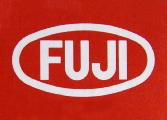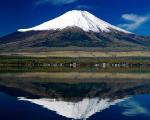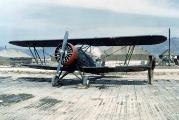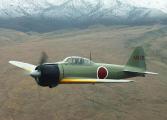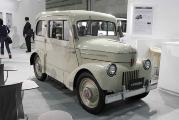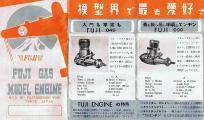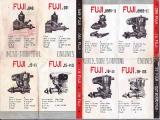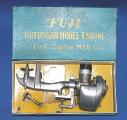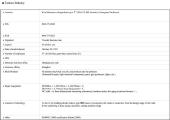The Fuji Story
by Adrian Duncan
 Chapter 1—Historical Background
Chapter 1—Historical Background Chapter 2—Fuji Corporate History
Chapter 2—Fuji Corporate History-
 Origin of Fuji Tokushu Kiki
Origin of Fuji Tokushu Kiki -
 The Case for a Possible Tachikawa Connection
The Case for a Possible Tachikawa Connection -
 The Fuji Bussan Connection
The Fuji Bussan Connection -
 Changes in the Late 1950's
Changes in the Late 1950's -
 Enter Tannan Industrial
Enter Tannan Industrial  Chapter 3—Fuji in the '50's: The Classic 099 Series
Chapter 3—Fuji in the '50's: The Classic 099 Series Chapter 4—The Classic Fuji 099 Series in the Sixties
Chapter 4—The Classic Fuji 099 Series in the Sixties
The corporate history of the manufacturers of the Fuji range is unusually complex as well as being greatly obscured by a combination of time and language barriers. Sorting it out from locations outside Japan and without any fluency in the Japanese language is a daunting task at best.
In writing a chapter on this topic, I'm very mindful of the probability that the majority of readers will have no interest whatsoever in the corporate background to the manufacture of the Fuji engines. Moreover, the nature of the subject matter does not readily lend itself to the use of illustrations to make the account more readable. Consequently I already hear a chorus of voices saying "To heck with all this bureaucratic BS—let's get to the engines themselves!". All those harbouring such thoughts are hereby cordially invited to proceed directly to Chapter 3—I won't be offended! For the rest, please read on...
The account which follows has been derived from a combination of close scrutiny of a variety of Fuji leaflets and labels together with the extraction of as much corporate information as possible from various data sources primarily accessed through Google Japan. For the latter effort, the main credit is due to Mel Reid, who has worked tirelessly in this area of research. If there is a reader out there who is fluent in Japanese and is willing to provide further assistance, we would be immensely and openly grateful! We feel that we've gone as far as we can without such assistance.
The sequence of corporate entities which guided the fortunes of the Fuji range seems reasonably clear. However, we acknowledge that many of the fine details such as dates and precise roles remain obscure, thus leaving ample scope for further research. We hope very sincerely that others may feel inclined at some point to take up this challenge!
In this chapter, we'll set out what we have been able to deduce from the limited amount of information available to us from where we sit. We would be delighted if this served as the groundwork for others possessing a closer knowledge of the facts or having both the time and opportunity for further research to add their insights to ours. As it is, we'll just do the best that we can.
The leaflets and box labels associated with the earliest Fuji products make it abundantly clear that the original manufacturer of the range was a Tokyo-based company known as Fuji Tokushu Kiki Work. This translates more or less into Fuji Specialty Machinery Works. We saw in Chapter 1 that the name Fuji is not derived from any direct connection with the famous mountain of that name, since Tokyo is some distance away from Mount Fuji. Nonetheless, we did note a connection of sorts. Mount Fuji has great cultural significance for the Japanese people, being held in great respect as the "peerless mountain". Accordingly, the name "Fuji" applied to a product or a business denotes "quality" or "peerless" to the people of Japan. The name of the manufacturer with which we are concerned thus translates more or less into "Peerless Specialty Machinery Works" as far as a Japanese native would be concerned.
Also in Chapter 1, we cited several references which give the date of the commencement of Fuji production as 1949. Given the fact that there is currently no evidence that Fuji ever produced any spark-ignition models, there seems little reason to question this date unless further persuasive evidence comes to light.
Origin of Fuji Tokushu Kiki
The question of the origin of the Fuji Tokushu Kiki company is one that remains very much open to debate. The problem is that there is currently very little evidence upon which to base such a debate! There appear to be three broad possibilities:
A 1949 Startup?
It is an undeniable possibility that Fuji Tokushu Kiki was established from scratch in 1949 as an entirely new small-scale company. This is certainly consistent with the fact that production figures during the first few years appear to have been relatively small. Unfortunately, an extensive search of Japanese corporate data which are available on line has failed to turn up any record of a company of this name being established at the right time. Hence there is currently no evidence whatsoever to support this possibility.
Expansion into the Model Engine Field
One plausible scenario would be for the manufacture of model engines to have been added to the business portfolio of an established company already engaged in some other line of work. To test this possibility, Mel Reid undertook an exhaustive search of Japanese companies called Fuji Tokushu Somethingorother. The most promising candidate was a present-day company called Fuji Tokushu Corporation which was established in Tokyo in 1938 for the purpose of making air conditioning systems and "specialty products" (hence the term "Tokushu" in the company name).
Although there is at present absolutely no direct evidence, it is possible that the Fuji model engine venture was a sideline or an offshoot of this company. There are doubtless other companies which might be connected in this way—we simply don't know.
Establishment as an Independent Offshoot
The early post-war Japanese business community underwent a series of significant upheavals as the country attempted to gain control of a highly unfavourable economic situation and restore confidence in the Japanese business community. A number of major industrial conglomerates became fragmented as a result. It is possible that the Fuji model engine enterprise may have begun during this period as an independent offshoot of a larger company.
Mel Reid's research has identified several possibilities in this context. One is the Fuji Electric Company, which was established in 1932 and is still operating today. As well as motors, generators, etc., the company makes pumps and compressors. More interestingly, it has been possible to confirm that they did at one time have a subsidiary called Fuji Tokushu! However, we have been unable to find any information about this latter operation beyond its name. Consequently, there is no direct evidence at present to support this possibility.
Another potential candidate is Fuji Precision Industries, which arose from the ashes of WW2 as a result of a 1945 restructuring of the former Tachikawa Aircraft Co. This company had manufactured Zero fighters and other military aircraft during WW2 but was forced to divert its capabilities into non-military production following the conclusion of the war. That did not alter the fact that it was unquestionably an air-minded company possessing the technical expertise to design and manufacture model aero engines.
The Case for a Possible Tachikawa Connection
The only one of the above possibilities for which a cohesive circumstantial argument can presently be developed is the last-mentioned, namely the Tachikawa connection. Since this is a fascinating tale in itself which throws considerable light upon the effect of WW2 upon Japanese industry in general, it seems well worth setting down here since if nothing else it may help to clarify the business context within which the Fuji model engine manufacturing enterprise was established.
However, we must caution our readers that the evidence is entirely circumstantial. Consequently, this connection cannot in any sense be regarded as substantiated. Moreover, honesty compels us to admit quite freely that in the context of this study of the Fuji model engine range, the origin of the Fuji Tokushu Kiki company is really of academic interest only. Accordingly, those wishing to skip this line of entirely circumstantial argument are invited to move directly to the following section of this chapter. For the rest of you, we'll share what we've learned.
The Tachikawa Aircraft Company Ltd had its origins in 1924, when Ishikawajima Shipyards (the future IHI Corporation) established a subsidiary company, the Ishikawajima Aircraft Manufacturing Co. This company's first design was a primary training aircraft called (in Japanese) the Red Dragonfly.
In 1936, the Imperial Japanese Army acquired a controlling interest in the Ishikawajima company, renaming it the Tachikawa Aircraft Company Ltd. This company manufactured a number of aircraft types, mostly training models and fighters for the Imperial Japanese Army. Some of these were in-house designs which were put into full production, while a number of others were either short-run specials or prototypes that did not enter production. In 1940, the company received license-production rights from its future American adversaries to the Lockheed Model 14 Super Electra, which it produced as the Army Type LO transport. Tachikawa also produced aircraft designed by other Japanese manufacturers.
During the war, Tachikawa manufactured an extensive range of military aircraft, including the famed A6M Zero fighter made to the design of Mitsubishi. Tachikawa was particularly involved with the engine development and production aspects of the Zero project. The Zero was noteworthy for the excellence of its engineering design and for its pioneering use of modular construction in its manufacture as well as its outstanding performance. The allied test pilot team responsible for the evaluation of captured enemy aircraft objectively assessed it as "the finest fighter in the world until mid-1943".
It's an intriguing and undeniably attractive possibility that the same expertise that went into the Zero may possibly have been applied to the manufacture of the Fuji model engine range! Let's look at the circumstantial case that can be made for this scenario.
The full-scale aeronautical manufacturing activities of the Tachikawa Aircraft Company were ended by the terms of the Japanese surrender to Allied forces in August 1945. The Tachikawa Aircraft Company and its fellow Japanese aircraft manufacturer the Nakajima Aircraft Co. were both dissolved and merged into a new entity known as the Fuji Sangyo Corporation. This new organization very shrewdly based its business plan upon meeting the fundamental ongoing needs of the Japanese people in the foodstuffs and transportation sectors, beginning immediately to diversify into a number of different subsidiaries.
Although its production facilities had suffered extensive damage during WW2, much of Tachikawa's very considerable technical expertise remained at the disposal of the new conglomerate. As part of the above-noted restructuring, the staff of the former Tachikawa Aircraft Company were re-deployed within a new subsidiary known as Fuji Precision Industries. Management immediately began to search for other forms of manufacturing to which their capabilities could be applied.
Motivated by prevailing gasoline shortages in Japan, the new subsidiary immediately began to develop a battery-powered electric car to be marketed under the Tama brand name. In Japanese, the name "Tama" means ghost, spirit or soul, thus reflecting the ultra-quiet operation of these vehicles.��Following a fairly lengthy development period, commercial production of Tama electric cars commenced in around 1949, with three versions being produced—the E4S-47 and the "Junior" (both 4-seaters) and the 5-seater "Senior".�
In 1950, changes in Japanese corporate legislation forced the formal disassociation of Fuji Precision Industries from the Fuji Sangyo Corporation, but this had little or no effect upon the company's activities. Following their initial success with the Tama electric automobiles, the company commenced the development of their own conventional automobile engine and entered the field of conventional automobile manufacture. Their first such product was the highly-successful 1952 "Prince" automobile, so-named in honor of Prince Akihito's formal investiture as Crown Prince in that year.
At around the same time, the company adopted the name Prince Motor Company. Under this name, it became highly respected for its range of premium-quality automobiles. The organization possessed a level of engineering and technical expertise which was then unrivalled in Japan, largely because of the wartime aircraft production and engine development background of its technical staff. Prince Motors eventually merged with Nissan Motors in 1966, thus making Prince's outstanding technical capabilities available to Nissan.
Returning to the early post-war years, the ban on Japan's involvement with full-scale aircraft production ended in November 1949. The fact that Fuji Precision Industries had never lost its leaning towards involvement in the aviation industry is clearly demonstrated by the fact that immediately following the lifting of the ban, the company returned to its roots by establishing a subsidiary called the New Tachikawa Aircraft Company Ltd. The reconstituted full-size aircraft manufacturing venture was not however a long-term commercial success, and by 1955 the company had ended its involvement with the full-scale aviation industry once and for all.
Given the nature and scope of the above activities, it must surely be obvious that as of 1949 the manufacture of model engines would have appeared commercially inconsequential to Fuji Precision Industries. Accordingly, if the Fuji Tokushu Kiki company was indeed an offshoot of Fuji Precision Industries, then its establishment must surely have been as much a labour of love as anything else. Perhaps a former Tachikawa employee within the parent company simply wished to resume a connection with aero engines, regardless of the scale.
If someone within the company had wished to re-enter the aviation field through the manufacture of model aero engines, it would have made complete sense to do so through the establishment of a subsidiary venture. Such a move in this instance might have seen Fuji Tokushu Kiki established for the purpose of manufacturing model engines while Fuji Precision Industries maintained its focus on the far larger-scale activities which were to take them so far.
There are parallels even in Japan for the establishment of model engine lines as offshoots of far more significant companies having nothing to do with modelling—the Mamiya range, for example, was manufactured by a completely independent offshoot of the prestigious Mamiya camera company founded by a former Mamiya Camera Co. employee. The Ueda engines in Japan as well as the Nordec and AMCO ranges in England were likewise introduced by established companies whose main business had nothing to do with model aircraft. All of these ranges appear to have fallen into the "labour of love" category, and there is no reason to suppose that Fuji could not have had a similar genesis.
Further research might well confirm or refute the existence of the connection just discussed. We do not claim it as an established fact—rather, we simply point it out as a possible avenue for further research. Our presenting the above case here must not be taken to imply that we are necessarily convinced by our own arguments—it's simply that this is the only one of a number of possible scenarios which can be argued at all on the basis of present evidence. We'll argue the others just as strongly if any evidence becomes available in the future!
Having gone through the above unproven scenario in some detail, we will now attempt to trace the various corporate changes which influenced the fortunes of the marque from 1949 onwards.
The Fuji Bussan Connection
The manufacture of the Fuji engines by Fuji Tokushu Kiki evidently continued from 1949 through to 1954. Throughout this period there appears to have been a notable lack of sophistication in the company's marketing efforts, particularly in terms of overseas sales. Evidently they were sufficiently occupied in developing and manufacturing the engines, and the relatively small scale on which manufacturing seemingly took place at this time meant that finding domestic buyers for their output presented far less of a challenge than it would have done for a larger-volume producer. Basically, at this stage the venture was technically-driven rather than being sales-oriented.
Most of the leaflets which came with the engines prior to 1954 appear to have been in Japanese, implying little concern with English-speaking markets at that time. However, this changed dramatically in 1954 when two new corporate entities entered the picture. These were Fuji Bussan KK and the Fuji Bussan Co Ltd Both names appeared on the packaging and promotional material supplied with the engines—the name of the "KK" company name appeared on the instruction leaflets supplied with the engines while the boxes carried the "Co Ltd" company name. The name Fuji Tokushu Kiki disappeared completely from the Fuji record as of 1954, making its final appearance in that year on the cases of the later variant of the .29 cu." Fuji Silver Arrow model.
The name "Fuji Bussan" translates very roughly into "Fuji Products", which is completely consistent with the companies' business activities. Under Japanese corporate law the KK and Co Ltd company registrations were (and are) entirely distinct. The "KK" form of company registration had been in existence for many years, having first been used in 1873. The letters stand for "kabushiki kaisha", which translates into stock company and is thus more or less synonymous with the familiar American term corporation (in Britain, a publicly listed company (PLC), or Akitengesellschaft (AG) in Germany). This form of registration required the posting of a very substantial bond as well as the use of a registered trade-mark, but it did allow the company to trade its stock on the open market.
By contrast, the "Co Ltd" form of company registration was relatively new, having been introduced shortly after the conclusion of WW2. This step was possibly motivated by the greatly increased level of interaction with Western society in general, but it's perhaps more likely that it was intended to provide smaller Japanese businesses with greater flexibility during their start-up and expansion phases. The revitalization of the Japanese economy was the primary challenge at this time, and the new registration option was doubtless intended to encourage small-scale entrepreneurial activity. This form of registration had far lower bonding requirements as well as limiting the company's liability, the downside being that there were severe restrictions upon the company's ability to raise outside capital. It was perhaps best suited to small family-owned operations—the Enya Metal Products Co Ltd is a familiar example.
Given the above facts, the two distinct registrations would appear at first sight to imply that Fuji Bussan KK and the Fuji Bussan Co Ltd were separate corporate entities. However, this cannot be taken for granted by any means—it is entirely possible that the two companies were in fact one and the same! Odd though this may seem, it appears that under Japanese corporate law there's nothing to stop a KK registered company from representing itself as a Co Ltd organization in a promotional context. This might be seen as an advantage for markets in which such a representation would be more comfortably familiar. There are precedents for this being done.
Even if this were not the case and the two Fuji Bussan entities were in fact distinct, both the coincidence of names and the common focus on the Fuji model engine range make it all but certain that the two Fuji Bussan entities were directly related, with one most likely being a subsidiary of the other. Based upon his own extensive career involvement with the British corporate sector, Mel Reid has suggested that it is most likely that the KK firm would have been the parent company while the Co Ltd entity was the subsidiary. It is apparently common practise in Britain to have a plc company owning a number of�Ltd companies which do the actual work while the parent company checks the books and reaps its share of the profits. It may well be that the same practise was followed in the case of Fuji Bussan—we simply don't know at this point.
However the two entities were related and regardless of their respective roles, there's no question whatsoever that it was from this point onwards that we see a greatly increased level of concern with the marketing of the engines as opposed to merely their manufacture. There's no doubt at all that the Fuji Bussan organization entered the picture with marketing ambitions which extended well beyond Japanese shores. Their advent coincided with a significant upgrading and Anglicization of Fuji's packaging, while leaflets with engines destined for overseas markets were now also printed in somewhat clumsy English. These moves reflected a sincere effort to market the engines world-wide for the first time.
At present we have absolutely no evidence regarding the extent to which Fuji Bussan was involved in the manufacturing of the engines as opposed to their marketing. The complete disappearance of Fuji Tokushu Kiki from the record makes it appear most probable that Fuji Bussan took over both the manufacturing and marketing from Fuji Tokushu Kiki, establishing manufacturing and marketing divisions within their own corporate structure. However, the possibility can't be completely discounted that Fuji Tokushu Kiki carried on in the background as the manufacturer, at least for a time. Or perhaps they were reorganized as the "Co Ltd" partner to continue their manufacturing role, while the "KK" entity handled the marketing side. Again, we simply lack any evidence to settle this point one way or the other.
Some confusion has been thrown into this already-complex picture by the documented existence of another entity identified as "Fuji Trading". Labels bearing this name have been encountered with several NIB engines destined for the US market at around this time. However, the fact that the name never appeared on any official Fuji packaging or leaflets implies that this may well be a red herring—it may have been no more than a rendering of the name "Fuji Bussan" into an Anglicized form which would be comfortably familiar to North American customers. Alternatively, it may have had no corporate connection with Fuji Bussan, being merely a warehousing and shipping company coincidentally bearing the Fuji name (very common in Japan). A major company of this nature still operates today under the same name.
One very frustrating feature of the leaflets issued with the engines during this period is the fact that they included no contact information whatsoever for either the manufacturers or distributors of the engines. It is thus impossible to keep track of any relocation initiatives which may have taken place during these years. This must have been as frustrating for the customers as it is for us today—where were they supposed to go for service or spare parts?
Changes in the Late 1950's
By 1957 the Fuji range had begun to gain a foothold in the world model engine market, largely as a result of the manufacturer's firm adherence to a very logical policy of staying out of the high-performance race and focusing instead on producing dependable low-cost engines for sport and recreational flying. Indications are that the expanded sales potential of the range was beginning to tax the capacity of the original factory (assuming that it was then still in use).
Serial numbers of Fuji models dating from the latter half of the 1950's indicate conclusively that production figures took a quantum upward leap starting in around 1957. Not only that, but from 1957 onwards we can document a rapid acceleration in the process of transforming the Fuji marque from a basic and somewhat archaic range into the modern and completely up-to-date range that it was to become during the following decade.
Quite apart from this, it is also from around 1957 onwards that we begin to see a marked diversification of the product lines sold under the Fuji banner. In 1957 the company began to market outboard motors in both .049 and .061 cuin displacements, following these later with a series of .15 cu." "Seahorse" models. The pressure die-castings used in the manufacture of these units were little short of works of art, displaying an almost virtuosic mastery of die-making and casting of a standard not previously seen in connection with the Fuji range.
Overall, it's apparent from the above factors that demand for the range (or the ambitions of the Fuji Bussan Co.) as well as the broadening scope of the products themselves had outstripped the ability of the original Tokyo factory to keep up. Not only that, but the technical demands placed upon the manufacturing arm, particularly in the area of die-casting, had increased significantly. If it had not already taken place, a change in manufacturing arrangements was clearly in order. Such evidence as we have been able to gather is entirely consistent with the notion that the Fuji Bussan organization decided at this point to take steps to greatly expand both the scale and scope of manufacture of the ever-expanding Fuji range.
We must now stress that we are forced once more into the realm of speculation to a significant extent when attempting to sort out this very dynamic period in the history of the Fuji marque. We will proceed on the basis that whatever scenarios we may propose must at least be consistent with such observed facts as are available to us.
As noted earlier, serial numbers from the various models manufactured from 1958 onwards are up to an order of magnitude higher than those seen on models dating from before that year. It's very difficult to explain this other than by postulating a major expansion of the company's production capacity at around that time. Moreover, the diversity and complexity of the products concurrently entered a major expansion phase, implying a greatly stepped-up development program along with a substantial broadening of the manufacturer's technical capabilities.
Leaflets supplied with the engines into the early and mid 1960's continue to bear the names of both Fuji Bussan Co Ltd and Fuji Bussan KK. This may be taken to imply that the respective roles of these corporate entities (whatever those roles were) remained unchanged at this time. However, a new name now appeared in the Fuji family—that of the "Fuji Engine Manufacturing Company". This name was attached to the outboard motors which began to appear in 1957, as depicted in our earlier illustration.
There is certainly an implication here that at least this aspect of Fuji's production activities may have been entrusted to a different manufacturer as of that date. Indeed, the possibility cannot be discounted that all Fuji manufacturing had then been entrusted to this new company, with Fuji Bussan left free to focus upon the marketing role. However, if this were the case then it's hard to see why the Fuji Engine Manufacturing Company would have been identified with the outboards but not with the aero engines. For this reason, a division of manufacturing responsibilities at this stage seems perhaps somewhat more likely.
Overall, it appears certain that by the late 1950's Fuji had made arrangements to greatly expand both the volume and scope of their manufacturing activities. It's unclear whether this was accomplished through the expansion of their original Tokyo manufacturing operation, through the abandonment of those facilities in favour of expanded facilities elsewhere or through an increased reliance upon sub-contracting for certain aspects of their overall production. However, this uncertainty does not in any way diminish our confidence in making the broader assertion.
Enter Tannan Industrial
Although at present we don't know exactly when this took place, there's no doubt whatsoever that at some point after 1957 the further development and manufacture of the Fuji range was entrusted to a precision engineering company known as Tannan Industrial. This company remains in existence today, albeit on a relatively modest scale, and it has been possible to learn something of its corporate history.
Nestling in the shadow of Mount Fuji at Yamakita, Tannan Industrial was established in October 1957. Its stated expertise was aluminium alloy die casting and machining, a perfect combination for making model aero engines.
It remains an open question whether Tannan Industrial was established primarily to play a role in the manufacture of Fuji engines or whether it undertook their manufacture after becoming established through other work. However, the timing of the company's establishment certainly coincides with the well-attested major increase in production rates and diversity of the Fuji range already discussed. This of course may or may not be coincidental.
If Tannan did indeed become involved at this stage (and we currently have no direct evidence for this), then their involvement may have been limited to the production of dies and die-casting, since this was their stated speciality at the outset. In addition, they may have taken on the relatively complex task of manufacturing the outboard motors, using the Fuji Engine Manufacturing Company name in that connection to keep that activity separate from their other work. The machining and assembly work relating to the aero engines may have continued to be carried out by Fuji Bussan, albeit at expanded premises.
Whatever the facts regarding their manufacturing role, there is a very real possibility that the further technical development of the Fuji range was subcontracted to Tannan Industrial at this time. There's no question that it was from 1958 onwards that we begin to see a significant acceleration in the rate of development of the Fuji marque into the completely up-to-date range that it was to become by the late 1960's. The introduction of a new development team is strongly implied here.
The combination of technical capabilities claimed by Tannan Industrial makes it clear that from the outset they were fully capable of undertaking all aspects of the manufacture of the Fuji engines. Moreover, it is certain that by the late 1960's they had done so. Our basis for making this statement is the fact that the Japanese-language leaflet with a domestic-market Fuji 15-IV in our possession specifically identifies Fuji Bussan Co Ltd as the "Sole Seller" and Tannan Industrial as the "Sole Manufacturer". This seems quite conclusive regarding the respective roles of the two companies and does not preclude the possibility that this division of responsibilities may have been established considerably earlier.
The Fuji 15-IV was introduced in around 1970, confirming that Tannan Industrial had assumed sole manufacturing responsibility prior to that date, with the Fuji Bussan Co Ltd continuing to handle the marketing chores. This division of responsibilities was still in effect at the end of the "classic" era with which we are concerned here.
None of this precludes the possibility that Tannan Industrial may actually have taken over Fuji's manufacturing role from the outset beginning in late 1957—we have no evidence that contradicts this. The continued appearance of Fuji Bussan on the leaflets and packaging would then have been related solely to their ongoing marketing role. Tannan's stated mix of expertise (die-casting and machining) is completely consistent with Peter Chinn's comment (made in the late 1960's when Tannan is known to have taken over) that Fuji was almost unique among model engine manufacturers in making their engines entirely in-house, including the castings.
Regardless of when Tannan actually became the sole Fuji manufacturer, the production figures from the mid 1960's to the close of the "classic" era, particularly with respect to the very popular .099 cuin models, make it clear that Fuji engine manufacture must have absorbed a major part of Tannan's production capacity, if not all of it. We do not presently know exactly when the manufacture of these engines by Tannan Industrial ceased, but whenever it came about the loss of that business must have represented a significant blow for the company. The Fuji name and associated business assets were subsequently acquired by the Model Engine Company of America (MECOA), which continues to manufacture (as of 2011 at least) a line of modern engines under the Fuji banner, along with a number of other lines which they have acquired.
Happily, Tannan seems to have successfully overcome any temporary difficulties which the loss of the model engine manufacturing may have created. The company remains very much in business today (2011), albeit on a relatively modest scale, apparently functioning as a jobbing engineering firm and making components for the automobile industry amongst others. Interestingly enough, the name, address and even the telephone number of the company as printed on the previously-mentioned 15-IV leaflet are identical in all respects to current (2011) information available on Google Japan for Tannan Industrial. Seemingly, things move slowly in Yamakita!
Having taken our readers through the rather convoluted corporate history of the Fuji venture as well as present circumstances allow, it's now time at long last to begin our detailed examination of the series of classic .099 cuin models by which Fuji is perhaps best remembered today. We will do so in the following chapter.
